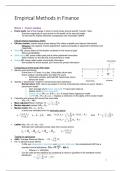Summary
EMF P2 - Complete Summary
- Course
- Institution
This summary outlines the main topics for the Part 2 Empirical Methods in Finance subject taught by Frank de Jong and Joost Driessen. Subjects: Event studies, Panel data, Time series and Machine Learning.
[Show more]



